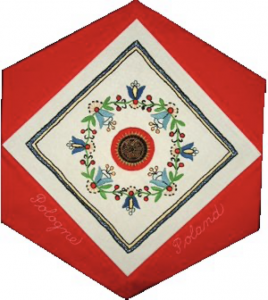Poland

The Block
Polish folk art customs are still an integral part of daily life and the two handcrafts featured on this block, stitched by Halina Urbanowicz, reflect centuries of tradition, kept alive in each region of the country. At the centre is a hand-carved brooch with brass inlay. The brooch was a family heirloom donated by Anna Zurakowski. It is surrounded by a colourful circle of embroidered flowers.
As is the case with most other countries that have a rich tradition of folk costumes, the most distinctive feature on Polish clothing is often the ornate, embroidered embellishments. This centuries-old flower and leaf motif is a traditional design of the Kaszuby people of northern Poland, typical of the needlework adorning folk dresses worn during Polish celebrations.
Cultural Profile
Poland is a nation of contrasts: beautiful landscapes, industrial centres, the north’s rolling hills, and the central region’s flat, rich farmland. Poland’s territory has changed greatly over time. At one time, the country encompassed Lithuania, and parts of Ukraine, Latvia, Estonia and Russia. A multi-ethnic society during that time, today Poland contains little diversity. Almost 98 percent of the country’s population are ethnic Poles. The remainder are mainly Ukrainians, Belarusians and Germans. The official language is Polish, with English the most widely spoken second language.
Poland is home to the largest remaining herd of bison, Europe’s largest mammal, as well as the Wieliczka Salt Mine, one of the world’s oldest salt mines that now contains underground churches, a museum and tennis court. Poland is the birthplace of Nicolaus Copernicus, the astronomer and mathematician who laid the foundation for modern astronomy, and of Frédéric Chopin, a world-renowned composer and pianist.
Poles regard freedom as their most important value, often calling themselves the ‘nation of the free people.’ Honour is also valued and, with a history of resistance and determination often in the face of terrible odds, Poles possess a strong, independent spirit.
Catholicism is the dominant religion and many Polish traditions are rooted in the observances of the Catholic faith. Christmas celebrations with the ‘Twelve dish supper’ and Krakow crèches, Easter with the decoration of Eastern eggs, Palm Sunday, and the blessing of Easter baskets, Dozynki, the Harvest Festival, and All Saints Day, when graves of loved ones are illuminated with candles, are all important celebrations in Poland.
Folk art traditions are still very much a part of daily life. Weaving and needlework designs, wycinanki paper cut-outs and crochet lace made in Koniaków, are traditions that have endured for many centuries. It is said the lace makers use over 2,200 patterns to make various items. Linen and wool were the fabrics traditionally used to produce checkered and striped cloth, with cotton becoming popular after World War I. Wood carving is widespread in Poland to make religious statues or items such as plates and boxes which are then painted or embossed with metal.
Poles have played a major role in Canada’s history for decades. Many came here seeking a more secure life for their families, and while most arrived during the past 100 years, some came even earlier. Among them was Sir Casimir Gzowski, who arrived in the 1840s and became a leading engineer and railway builder. His contributions include the bridge connecting Fort Erie, Ontario with Buffalo, New York, and the Niagara Parkway.
With an opportunity to have their own land in Ontario, fourteen Polish Kaszub families soon followed, settling west of Ottawa in the region now known as Kaszuby (named for the part of northern Poland from which they came). Their presence marked not only the start of the Kaszub settlement in Ontario, but also the beginning of Polish settlement in Canada. The Kaszub’s fierce desire to preserve their regional culture also led to the founding of what has become the oldest continuous Polish parish in Canada.
Today, over one million Canadians are of Polish ancestry, and large Polish communities are present throughout the country. Canadians of Polish origin, working in all professions and businesses, have contributed to Canadian society in a number of areas including the sciences and arts. Through such means as dance groups, educational organizations like the Polish Canadian Research Institute, and cultural clubs such as Sokol, in Winnipeg, they maintain their culture and share their traditions with other Canadians.
Sponsor: Canadian Polish Congress
